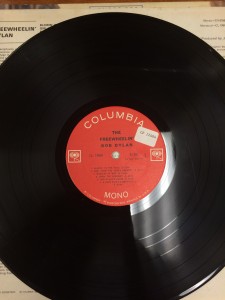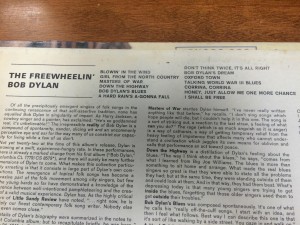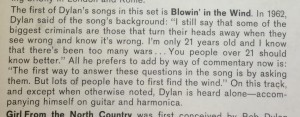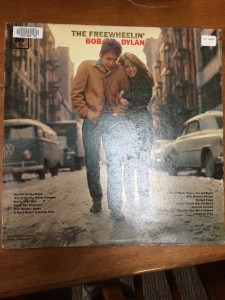
The Freewheelin’ Bob Dylan was released in 1963 by Columbia Records and acted as a distinct catalyst for change by promoting the Civil Rights Movement and supporting the anti-war movement toward Vietnam in the United States. This was Bob Dylan’s first successful album; it includes songs such as “Masters of War” and “Blowin’ in the Wind,” whose lyrics communicate his desire for peace and equality. Despite the specific political meaning of the songs at the time they were composed, these have become ingrained broadly across American social movements and remain powerful to this day. One reason Dylan was so successful as a cultural inspiration was that his music felt real and genuine to the audience: “Dylan’s words are performed: music, voice, and words come together to create a distinctive cultural artifact and not a verbalized poem” (Dettmar 101). The combination of the lyrics, sound, and message in Dylan’s work make The Freewheelin’ Bob Dylan a musical and political phenomenon that is respected even in modern times.

As a primary source, the long-playing record gives listeners a firsthand look into the mindset of Bob Dylan at the time. The back of the record jacket offers a collection of detailed information, with paragraphs describing segments of each song text, why Dylan wrote the song, where his inspiration for the song came from, when he wrote the song or what he intends to express in the song. For example, Dylan describes his song “Masters of War” as a “song of striking out, a reaction to the last straw, a feeling of what can you do?” Dylan’s perspective allows the reader to understand his emotions, motivations, and reactions to the events of his time. Elsewhere, he states that he generally “doesn’t sing songs which hope people will die, but I couldn’t help it in this one.” The combination of his description of the song’s intention and the confession of his rage give the song a background that may not have been established solely by the lyrics for the listener. Unlike other primary sources, these jacket notes on this LP give people a firsthand look into the thoughts of a young Bob Dylan. It becomes apparent that as a young man, he was passionate about specific political issues. For example, Dylan states on the description of “Blowin’ in the Wind”, “I’m only 21 years old and I know that there’s been too many wars.” This glimpse into the mind of Bob Dylan at the time his record was published offers valuable information to people who want to understand Dylan’s personal perspective on his first album. The record becomes a valuable primary source because it is more than just a recording, it has detailed information about how Dylan wrote the album and his thoughts at the time. The LP we consulted at the W.S. Hoole Special Collections Library is in good condition with minimal wear and tear to the record jacket. The jacket’s front cover portrays a picture of Bob Dylan and his girlfriend at the time, Suze Rotolo, huddled together walking down a city street in the cold. This quiet and simple image reflects the mellow character that pervades this collection of songs, and supports Dylan’s distinct antiwar protest in his lyrics by promoting an image of peace and simplicity. We were unable to listen to the LP, as it it was held in a special collections area with no access to a turntable, so we could only listen to the songs from a digitally remastered edition of the album online. While this is helpful for understanding and appreciating his lyrics, we were disappointed that we could not experience first-hand what it was like to listen to this LP in its original format, on a turntable.


One of Bob Dylan’s most well recognized songs of his career is “Blowin’ in the Wind” and it is featured on this record. This slow and simple tune questions the lack of peace in the world and also touches on civil rights issues in the United States. In the description of the background of “Blowin’ in the Wind” on the back cover, Dylan says that “some of the biggest criminals are those that turn their heads away when they see wrong and know it’s wrong.” Dylan made his civil rights viewpoints very obvious in this piece; this is important because his young age when he wrote the song and the appearance of this song on his second album demonstrates that Bob Dylan intentionally established himself as a political artist from early in his career. By limiting his style to bare-bones guitar and vocals, Dylan places his lyrics at center stage. While “Blowin’ in the Wind” makes a clear statement against war, it also an anthem during the civil rights movement in the United States and “Dylan sang it himself at a voter registration rally in Greenwood, Mississippi, in the spring of 1963” (Naylor 1). “Blowin’ in the Wind” was also performed on the steps of the Lincoln Memorial hours before Dr. Martin Luther King Jr. gave his ‘I have a dream’ speech. Part of the reason that Dylan has powerful songs is because he made an effort to not limit himself, “I’m not going to limit what I can say. I have to be true to the song,” Dylan once said (Browning 228). This allowed him to creatively express all of his ideas without restraint. “Blowin’ in the Wind” is a
landmark song that reveals Bob Dylan’s significant impact on anti-war and civil rights movements throughout history, extending into issues even today over 50 years later.
In summary, Bob Dylan’s renowned record The Freewheelin’ Bob Dylan has influenced and inspired groups as large as the audience at the “I Have a Dream Speech” and as small as the individual listener who purchased the album. His songs protest war and support civil rights in an “ubiquitous” and “elusive” way, and “they introduce a multitude of characters and give expression to innumerable points of view” (Dettmar 43). Due to the discrete lyrics Dylan uses, the descriptions and information given on the back cover give concreteness to the elusiveness of his songs. On the album, the antiwar message delivered in “Masters of
War,” The Civil Rights support given in “Blowin’ in the Wind,” along with the rest of the record shape his political standpoint and give his voice power. Because of the actual record cover, the imagery displayed reinforces his ideas and the descriptions on the back amplify his intentions.
References
Dettmar, Kevin J. H., ed. The Cambridge Companion to Bob Dylan Cambridge University Press 2009 Cambridge Companions Online http://dx.doi.org/10.1017/CCOL9780521886949
Naylor, Brian. “‘Blowin’ In The Wind’ Still Asks The Hard Questions.” NPR. NPR, 21 Oct. 2000. Web. 05 Oct. 2015. http://www.npr.org/2000/10/21/1112840/blowin-in-the-wind
Browning, Gary. “Bob Dylan: The Politics Of Influence.” Popular Music History 8.2 (2013): 222-239. Academic Search Premier. Web. 5 Oct. 2015.
Dylan, Bob. The Freewheelin’ Bob Dylan. [Sound Recording]. n.p.: [New York] : Columbia, [1963?], 1963. University of Alabama Libraries’ Classic Catalog. Web. 5 Oct. 2015.
Dylan, Bob. Blowin’ in the Wind. Bob Dylan. Columbia Records, 1963. Web.
Dylan, Bob. The Freewheelin’ Bob Dylan. Bob Dylan. Rec. Winter 1962. John Hammond and Tom Wilson, 1963. Hoole Special Collections Library. Web. 16 Sept. 2015.
Emma Callesen, Austin Halverson, Nolen Moore